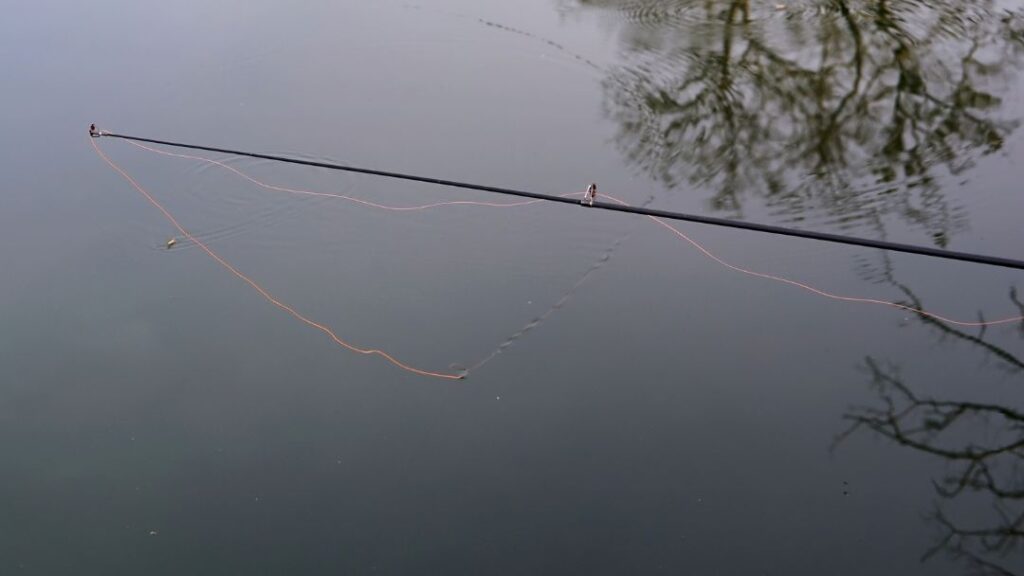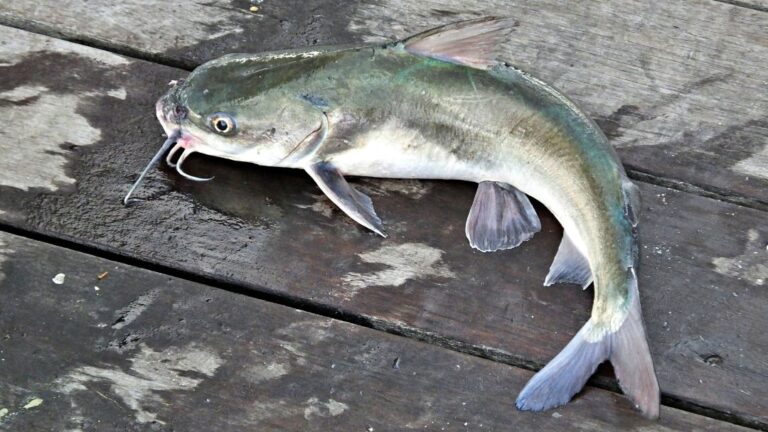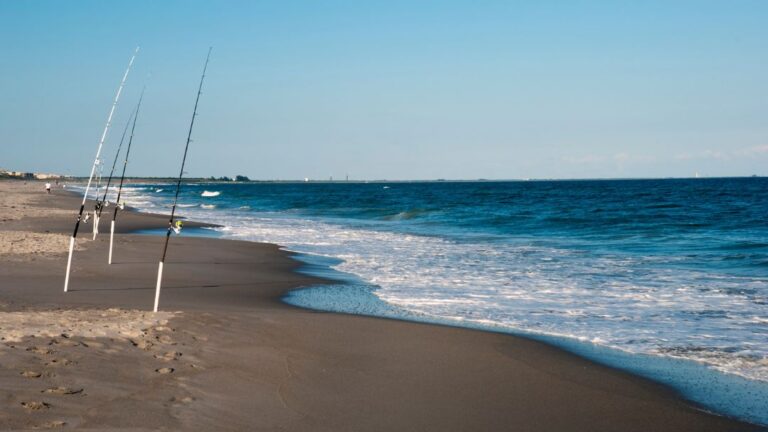Do you know which fishing equipment creates a connection between an angler and a fish? It is the fishing line! This flexible, high-tensile cord comes in various types and sizes. It will determine how much heavy and bulky fish it can handle. The same goes for salmon fishing.
Can salmon see the fishing line? Yes, salmon can see a fishing line as their retinas possess cones to see colors along with fine details. But the color visibility may slightly or significantly vary depending on the water depth level, water condition, and light condition.
Can Salmon See Fishing Line?
Of course, salmon can see fishing lines like other fish. But compared to nighttime, they can see fishing lines more clearly during the daytime.
Salmon fish can distinguish color as their retinas possess cones, which help them to see colors along with fine details.
In fact, researchers found that salmon fish may have an extra cone to see more colors than humans. They can even see rainbow colors due to their sensitive eyes.
However, instead of relying on colors, they give more focus on the contrast and brightness level.

What Factors Determine How Clearly Salmon Can See Fishing Lines?
Do you think salmon see all colors similarly from the top and bottom water?
There are various factors that affect how salmon see various colors in the water.
01. Fishing Line Thickness
Do you want to avoid spooking your favorite salmon fish? If so, you don’t want to use too thick a fishing line. Otherwise, the fishing line will be easily visible in the water.
Besides, salmon are intelligent! They gather information by eavesdropping. Hence, you want to use a light and thinner fishing line that can take more bites.
However, it is advisable to avoid using too thin fishing lines. They are more prone to become brittle gradually. Saltwater and UV rays can degrade their quality quickly.
The average diameter for the fishing line ranges from 0.2mm to 0.35mm. Anglers generally use 20-35 pound test fishing lines for salmon fishing.
02. Fishing Line Color
Choosing an appropriate fishing line color is crucial as it affects your fishing experience.
Salmon are not colorblind. They have cone and rod cells in their eyes to see various types of colors.
However, not all species of salmon fish have the same level of concentration for both cells. Some may have higher concentrations in cone cells than rod cells and vice versa.
But the question is: which fishing color is the best choice for catching salmon?
If you are fishing deeper than 50 feet underwater, it is best to use reds, oranges, greens, and blacks. But you might be wondering why you should opt for this color, right?
As the fishing line goes deeper, its color will be absorbed gradually. However, colors with longer wavelengths will be absorbed first and then the lower ones.
It is always best to avoid using any UV colors. After all, their colors remain almost the same in all depths due to shorter wavelengths.
03. Water Conditions
Water clarity is a vital aspect that determines how clearly fish can see underwater.
Dirty or murky water limits the visibility of salmon fish. They struggle to see the prey correctly.
Fish will heavily rely on the lateral line when the water condition is too bad.
Most expert anglers recommend using fast-action lures when the water is too dirty or murky. It increases the probability of predatory.
It is advisable to use green fishing lines in stained water as it matches well with the water’s color.
But if your fishing water is fully clear, you can use white or light blue color. Salmon will struggle to recognize these colors underwater.
04. Weather Conditions
Do you prefer to fish during darker conditions, such as cloudy conditions, or at night?
Compared to day conditions, salmon have a lower vision at night. However, they can detect lighting and sense their surroundings through their pressure-sensitive organs.
Seeing even UV colors in dark conditions is challenging for them. But reds and yellows are not the best fishing line color for salmon at night.
They may slightly see it even in darker conditions. Darker colors are a better choice during low-light conditions.
05. Water Depth
Another crucial aspect is the water depth. Some colors appear visible at the lower level inside the water, and others are less.
For example, oranges and reds are excellent choices for salmon fishing, especially in deeper water. After all, water will absorb these colors and make them less visible to salmon.
But purples and dark blues are not absorbed too much, even in deeper water. Hence, it is not the best choice in deeper water.
If you prefer a mid-range option that is not highly or minimally visible in water, greens, and yellows are good choices.
Can Salmon See Various Types Of Fishing Lines Similarly?
Fishing lines are mainly available in three types. Salmon fish will not see each of them in the same manner. It will vary depending on various factors.
Braided Fishing Line
This type of fishing line is known as one of the strongest fishing lines as it is made of synthetic materials, such as Dacron, Spectra, or micro-Dyneema.
Unfortunately, the synthetic materials used in braided fishing lines made them opaque. Hence, salmon can easily see them.
It doesn’t matter whether the fishing line is above or below the water. This type of fishing line is easily visible to salmon.
Fluorocarbon Fishing Line
Do you fish in clear or ultra-clear water? If so, Fluorocarbon is one of the best choices for salmon fishing.
This type of fishing line is made of vinylidene fluoride resin or fluoropolymer PVDF. They are almost invisible in water regardless of the water clarity level.
Fluorocarbon fishing lines have almost a similar refractive index as water. As a result, it disallows a significant amount of light to pass through the line.
If you want to implement finesse fishing techniques with increased bites, fluorocarbon fishing lines are the best choice.
Monofilament Fishing Line
When it comes to higher flexibility and ease of use, monofilament fishing lines are the top choice.
This type of fishing line is made of a single fiber of plastic or nylon material. But can salmon see a monofilament fishing line?
They are made of special materials that make them less visible underneath the water.
However, it is best advisable to use clear monofilament to trick salmon underwater. They remain invisible in all situations.
Their low visibility and single strand allow you to catch more salmon fish, especially in clear water conditions.
Why Is Fishing Line Color Important For Salmon Fishing?
Many newbies, as well as some experienced anglers, give less importance to choosing an appropriate fishing line.
The followings are the two primary reasons you should give special attention to choosing a particular fishing line color.
Careful Inspection
Imagine how you will feel if the fishing gear is invisible outside the water after placing it underwater. You would have no choice but to rely on the strike and bites.
Fashioning lines come in various colors. One of the primary advantages is helping anglers to track down the current position of the line.
You won’t always have to wait to receive an intense strike or bite.
It enables fishermen to change the location, direction, and angle of the fishing line based on the fishing condition.
Like Vs. Dislikes
Not all fishes are attracted to the same color. The same goes for salmon fishes. In fact, you can see different behaviors among various salmon species.
For example, Atlantic salmon are more attracted to greens, whereas Pink salmon are attracted to blacks and dark blues.
It is better to have a clear idea regarding what type of salmon is available in the fishing water.
This will help you choose the best color depending on the salmon’s species.
Can Fishing Line Color Affect Your Salmon Fishing?
Many new anglers often overlook choosing the right fishing line color for salmon fishing. It is necessary to be mindful when selecting a particular fishing line color.
Salmon live in both freshwater and saltwater. You must determine from where you are going to catch them.
For example, if you want to catch salmon from saltwater, light blue is the best choice. This color matches well with the water.
Greens, soil microorganisms, and plants are common in freshwater. If you want to catch salmon from a fishing line, a green fishing line is a perfect choice.
Are you an inexperienced angler? Wondering how to trick salmon in murky or dirty water during darker conditions?
Yellow works pretty well in dirty or murky water as it becomes almost invisible in such water conditions. However, salmon will avoid this clear in clear water unless it is hungry.
Do you have access to crystal-clear water? If so, it is best to use white or transparent fishing lines to make it almost invisible to salmon fishes.
Bonus Tips When Choosing A Particular Color Salmon Fishing Line
01. Pay attention to your fishing time. When fishing during bright sunny conditions, choose a clear that is less visible under the deepest water.
02. Choose a fishing line that creates a natural shade and the lowest contrast underwater. This will prevent salmon from figuring out the line quickly.
03. Make sure the fishing line is compatible with the fishing reels. Avoid adding extremely strong or thick lines, as they may fail to bear the force of the giant fish.
04. Don’t use regular fishing lines for ice fishing. Choose a specially designed fishing line with an appropriate color.
05. Make sure to consider a fishing line’s material, strength, visibility, stretch, memory, buoyancy, abrasion-proof, etc.
Wrapping UP
Are you still wondering about this question: can salmon see the fishing line? I have already given a clear answer in this content with pertinent details.
When choosing a particular fishing line for salmon fishing, you want to consider the water’s color and light conditions. These two attributes will affect the visibility of the fishing line.
Make sure to give additional importance to its features apart from the color. Also, track down its lifespan as fishing lines are made to last for a certain period, even if you don’t use it for a long time.






